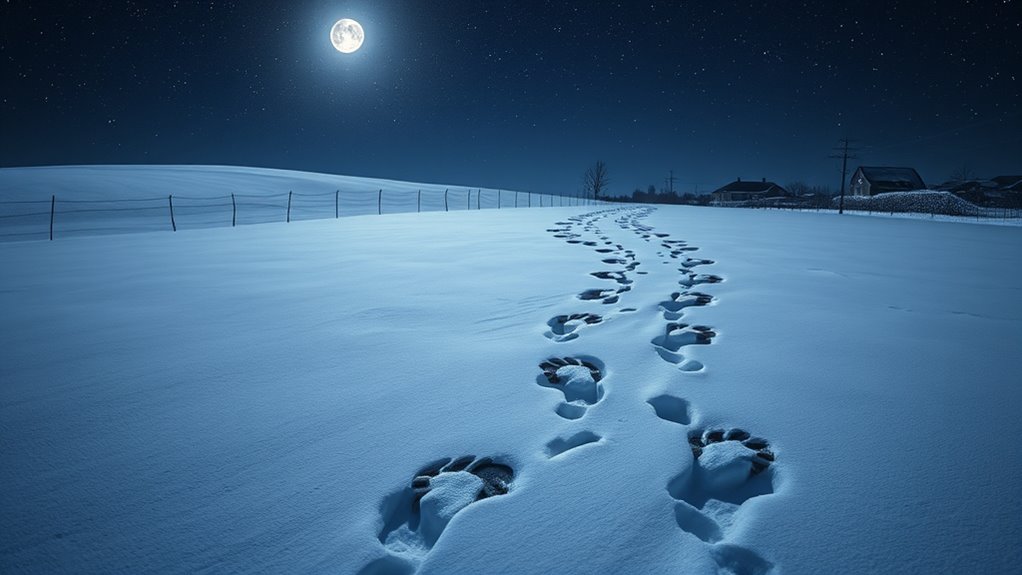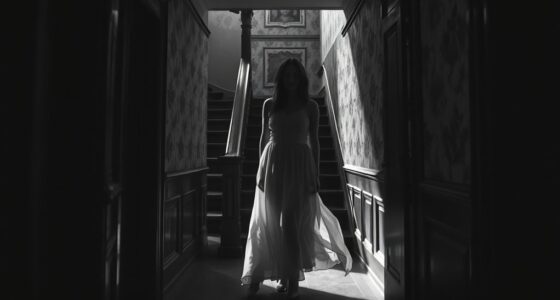In winter 1855, you encounter the strange Devil’s Footprints in Devon, where unexplainable hoofprints stretch across rooftops, fields, and snow overnight. These four-inch-wide prints with claw marks baffled locals and sparked fears of demonic activity, fueled by Victorian beliefs. Natural explanations like animal activity were overlooked at the time, keeping the mystery alive. If you’re curious about what made these footsteps so unsettling and how they remain unexplained, keep exploring this fascinating story.
Key Takeaways
- The Devil’s Footprints appeared overnight in winter 1855-1856 across Devon, stretching over rooftops and snowy fields.
- Footprints measured about four inches wide with claw-like impressions, traversing rooftops, chimneys, and open fields.
- Societal beliefs at the time interpreted the footprints as demonic or supernatural signs, fueling fears of malevolent spirits.
- Modern explanations suggest natural causes like animal activity, but no definitive proof has confirmed their origin.
- The phenomenon remains a mysterious event, exemplifying Victorian-era fears and the limits of scientific understanding.

In the winter of 1855-1856, a mysterious phenomenon baffled residents of Devon, England: a series of strange, unbroken footprints that stretched across rooftops, fields, and snow-covered ground for dozens of miles. These footprints, measuring about four inches wide with claw-like impressions, appeared overnight, seemingly out of nowhere, and defied logical explanation. As villagers awoke to this bizarre sight, speculation ran rampant. Some believed the footprints were the work of supernatural forces, perhaps demon or spirit activity, fitting into the era’s prevalent supernatural theories. During this period, society often viewed unexplained phenomena through the lens of religious and superstitious beliefs, which reinforced fears of malevolent entities invading the human world. The Victorian age, with its fascination with the supernatural, ghost stories, and spiritualism, provided fertile ground for such interpretations. People believed these footprints could be a sign of demonic activity or an omen from the supernatural realm, especially given their unusual shape and the eerie way they traversed rooftops and chimneys.
The historical context of the mid-19th century also played a role in shaping these beliefs. Scientific understanding was still developing, and many phenomena that we now explain through natural causes were attributed to supernatural or divine intervention. The footprints appeared amidst a time of religious fervor and societal upheaval, where unexplained events often reinforced existing fears or superstitions. Some local residents thought the footprints might belong to a supernatural creature or devil, hence the name “Devil’s Footprints.” Others speculated it was a punishment or a sign from God, warning of impending doom. These theories were fueled by the lack of immediate scientific explanation and the mysterious, untraceable nature of the footprints. Additionally, modern investigations into such phenomena emphasize natural explanations, which many researchers believe could shed light on the origins of the footprints. Interestingly, recent analyses of similar phenomena in other contexts have shown that animal activity can sometimes produce patterns that resemble mysterious footprints. Moreover, advances in forensic science have allowed scientists to analyze such mysteries more thoroughly, though the Devil’s Footprints remain elusive. The absence of conclusive evidence has contributed to ongoing debate about their true origin, leaving the mystery unsolved.
Despite the progression of science, many still find the footprints intriguing because they challenge conventional understanding. The footprints’ pattern, their sudden appearance, and their ability to cover such a vast area add to their mystique. While some skeptics argue natural causes—such as animals or human activity—could explain the phenomenon, no definitive evidence was ever found. The combination of supernatural theories and the historical context of Victorian England created a fertile environment for the legend to grow. Today, the Devil’s Footprints remain a fascinating mystery, reminding us how cultural beliefs and the lack of scientific knowledge can shape our interpretation of the inexplicable.
Frequently Asked Questions
Were Any Animals Harmed During the Footprints’ Appearance?
You wonder if any animals were harmed during the appearance of the mysterious footprints. Based on footprints analysis from various reports, there’s no evidence suggesting animals were hurt or involved. The animal tracks seem to be unrelated to any injured creatures, as they mainly show unusual patterns rather than signs of distress. So, you can be reassured that no animals appeared harmed during this strange event.
Did the Footprints Lead to Any Known Locations?
You might think these footprints could lead anywhere, but they actually follow a surprising path, almost like a secret trail. The animal tracks seem to defy weather conditions, crossing snow, ice, and even rooftops. Despite the mystery, the footprints don’t lead to any specific location or clue, leaving you with more questions than answers about their origin and purpose during that eerie winter night.
Were There Any Similar Sightings Elsewhere in 1855?
You might wonder if similar sightings occurred elsewhere in 1855. In the historical context, reports of mysterious footprints appeared in various regions, fueling paranormal theories about supernatural causes. While some believe these sightings were isolated, others think they reflect a widespread fear of unexplained phenomena during that time. These recurring reports suggest that the footprints captured public imagination and contributed to ongoing debates about the paranormal and mysterious events in the mid-19th century.
How Did Local Authorities Respond to the Mystery?
Ever wonder how authorities handle mysterious events like this? You see, local officials initially dismissed the public panic, but as footprints kept appearing, they launched police investigations. They tried to find logical explanations, but the strange tracks puzzled everyone. The authorities aimed to calm fears yet remained cautious, aware that such mysteries could stir widespread concern. Their response reflected a mix of skepticism and concern, trying to manage the growing curiosity and unease.
Have Modern Scientists Offered Explanations for the Footprints?
Modern scientists have explored the footprints through various historical investigations, but they haven’t reached a definitive conclusion. Some paranormal theories suggest supernatural or extraterrestrial origins, while others attribute the marks to natural causes like animal activity or unusual weather conditions. You should consider that many explanations remain speculative, and without concrete evidence, the mystery continues to intrigue. Scientific analysis remains limited, leaving the true cause open to debate.
Conclusion
As dawn breaks, the mysterious footprints vanish into the cold, dark night, leaving you to wonder if the devil himself danced across the snow. The silent, winding trail whispers secrets only the winter winds can understand, tempting you to believe in unseen forces. In this icy maze, the mystery lingers like a ghostly song, beckoning your curiosity to unravel the chilling enigma. Who or what truly carved those ghostly paths in the winter’s hush?









